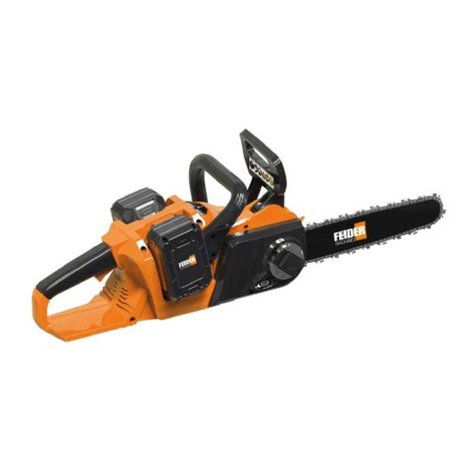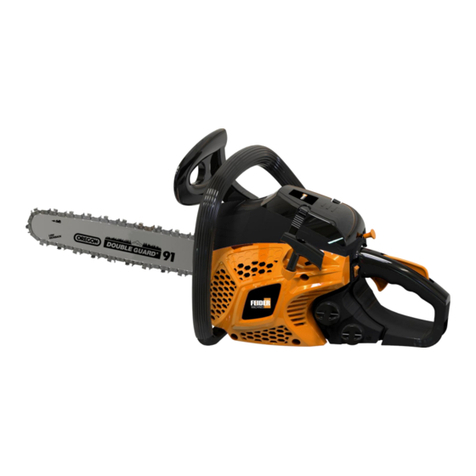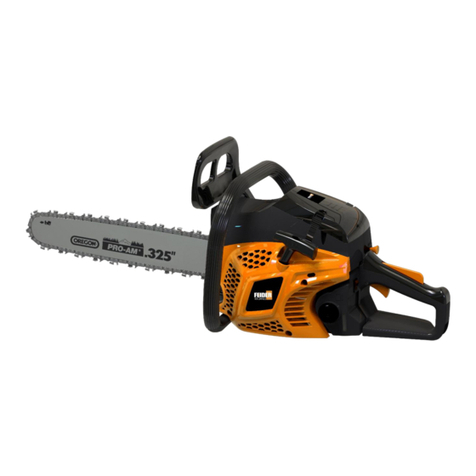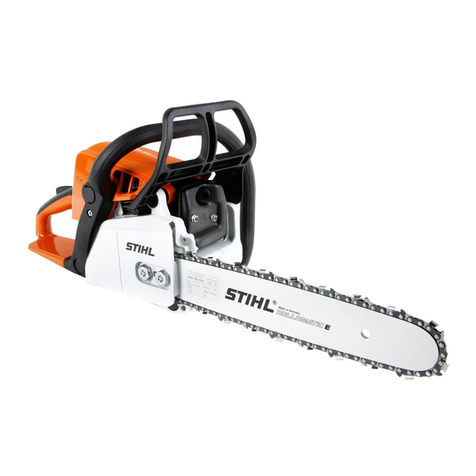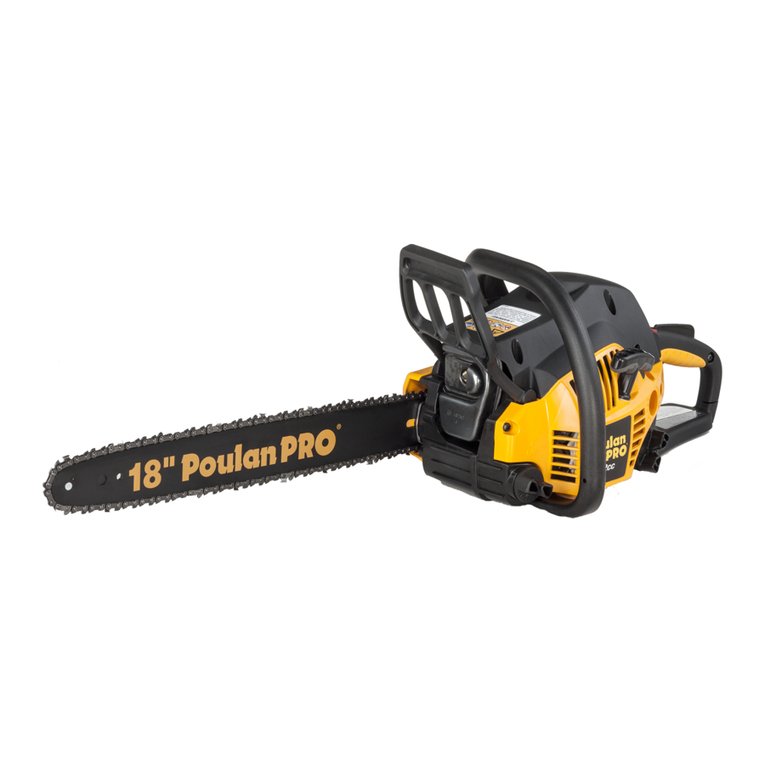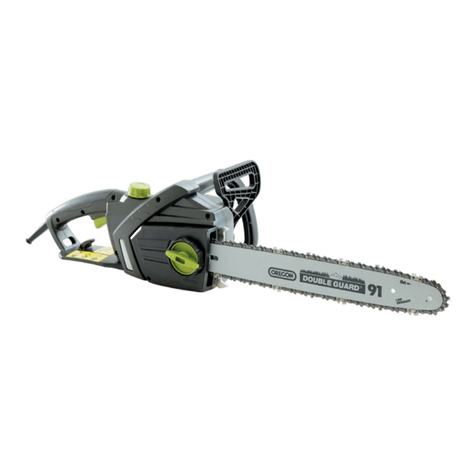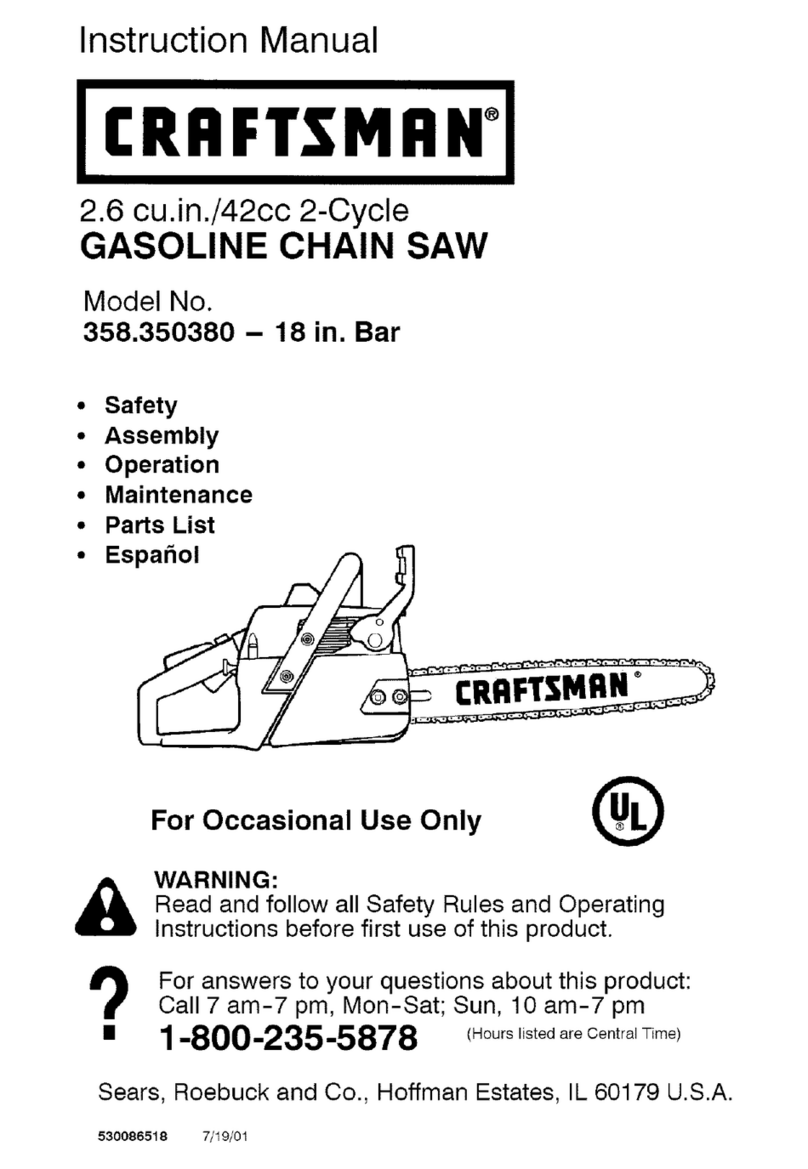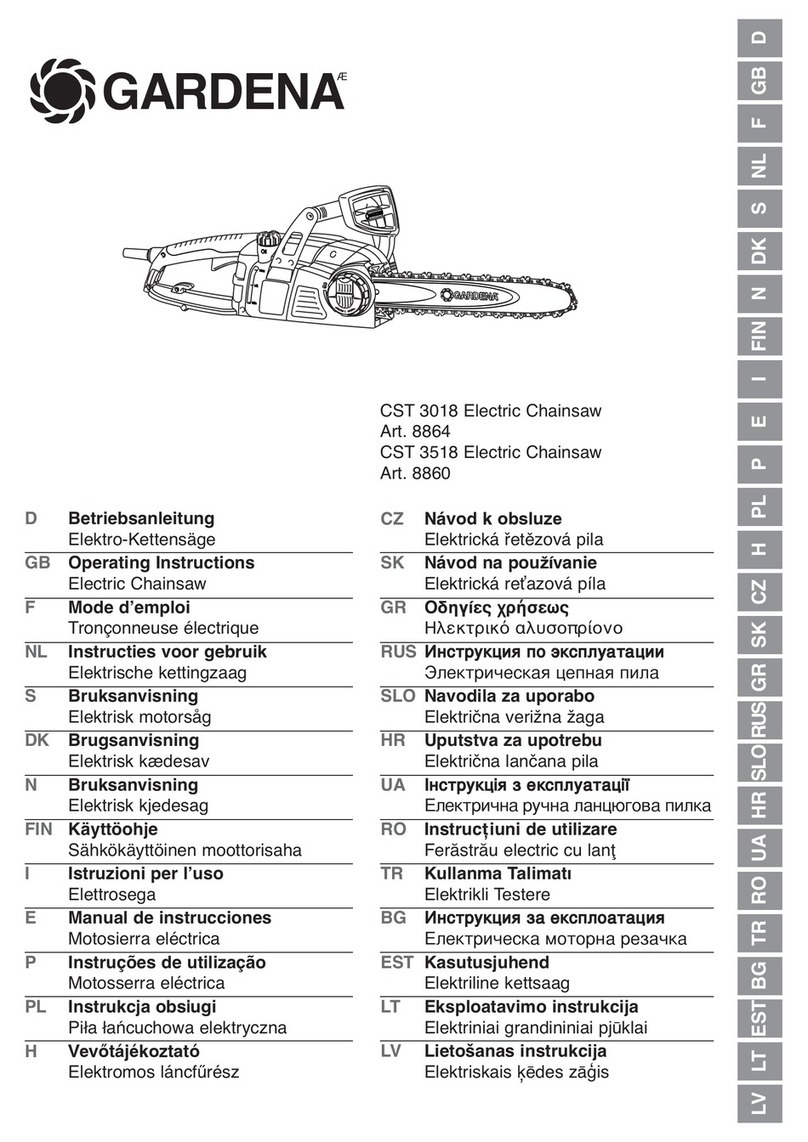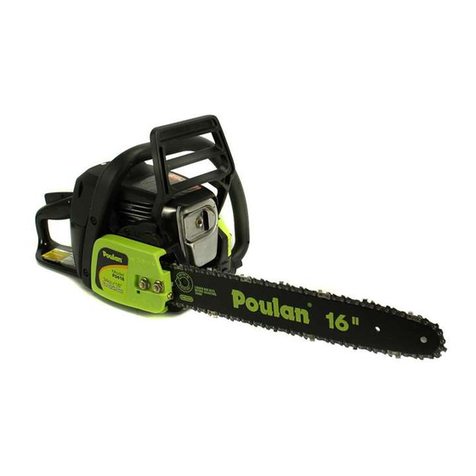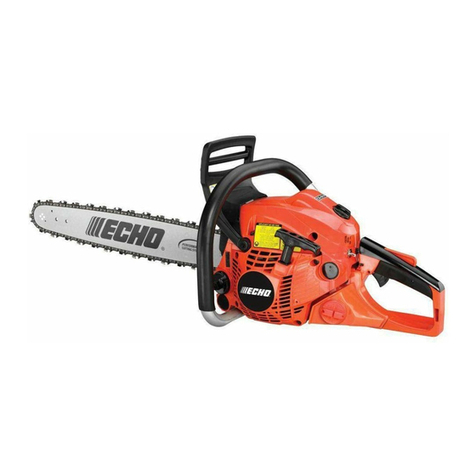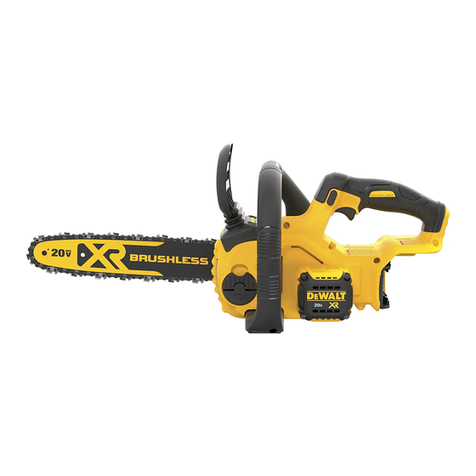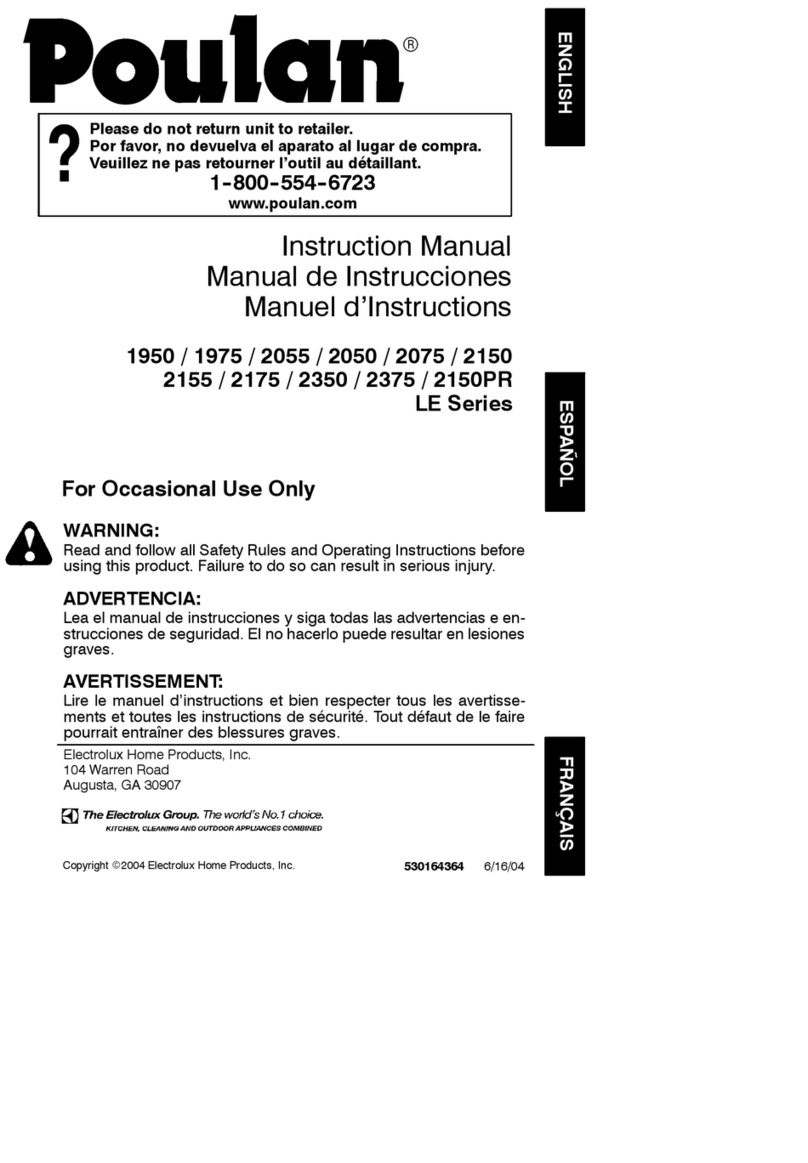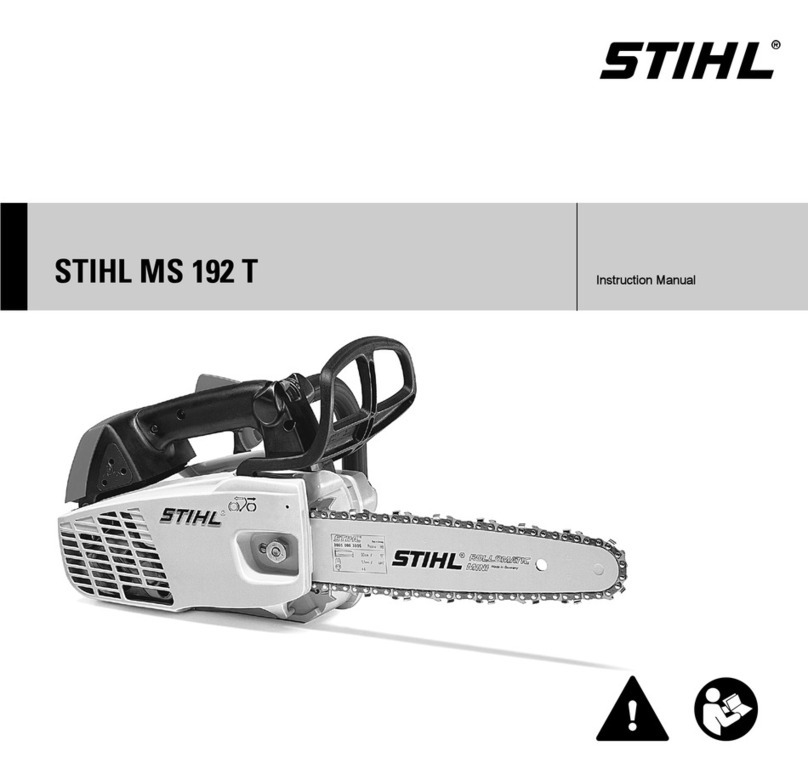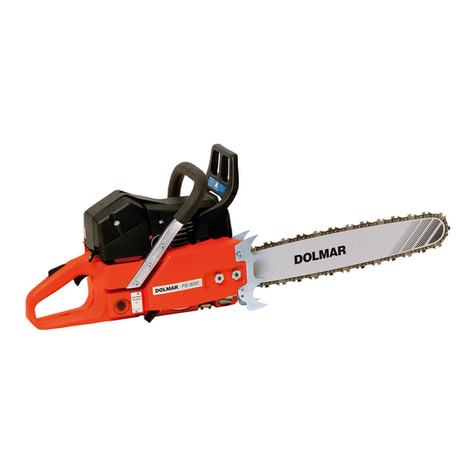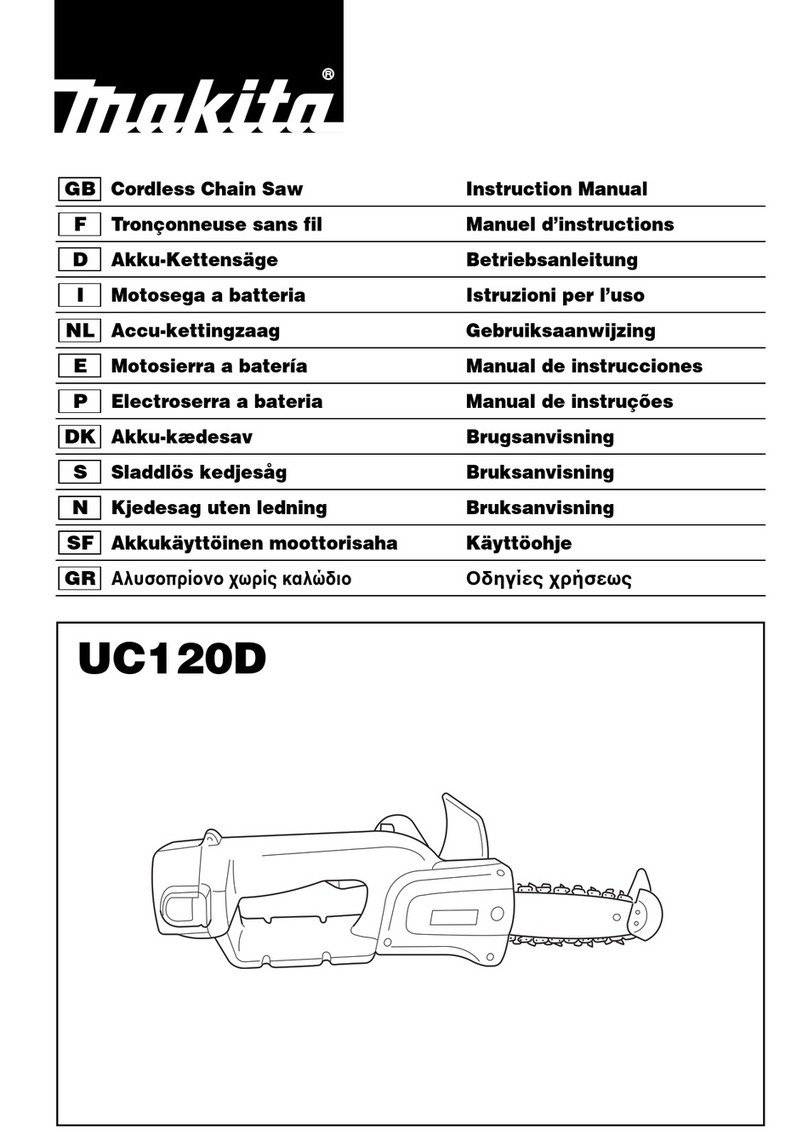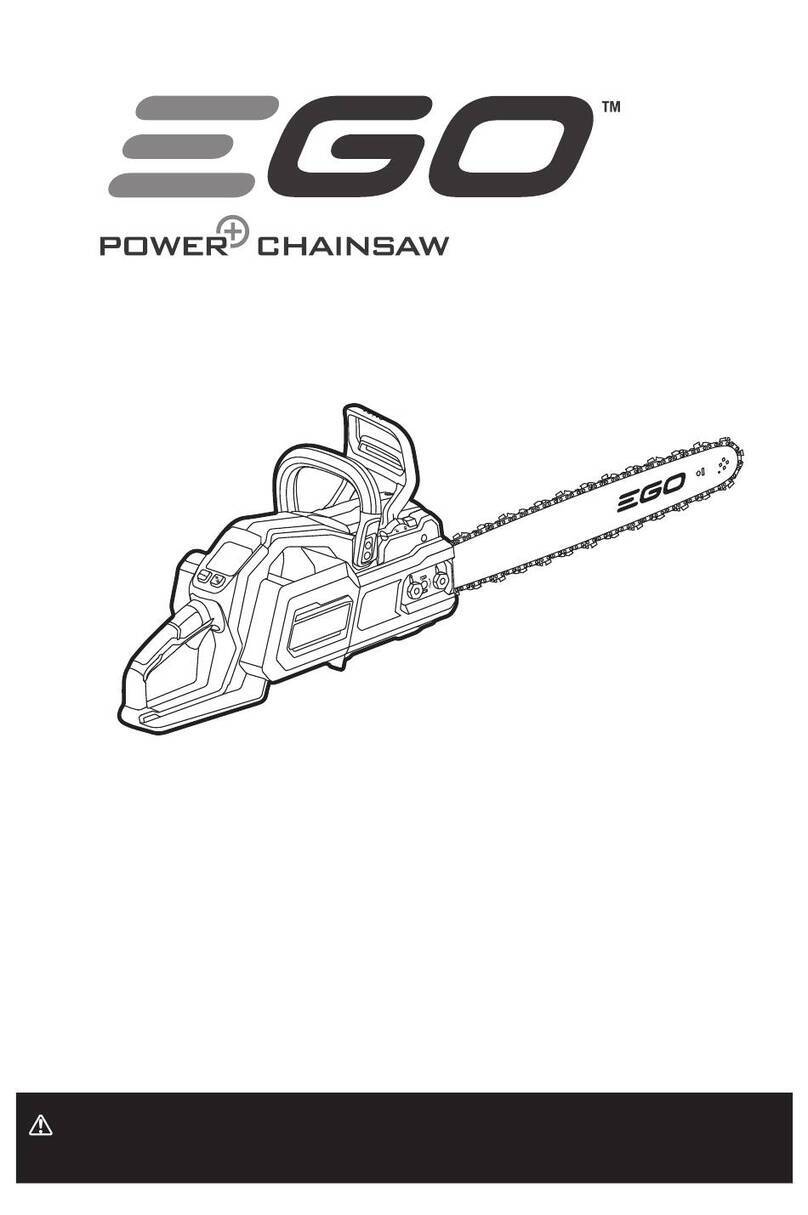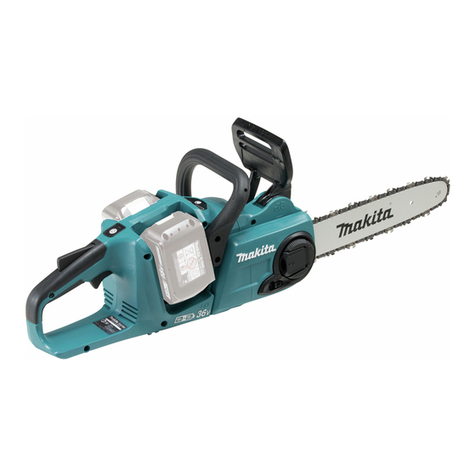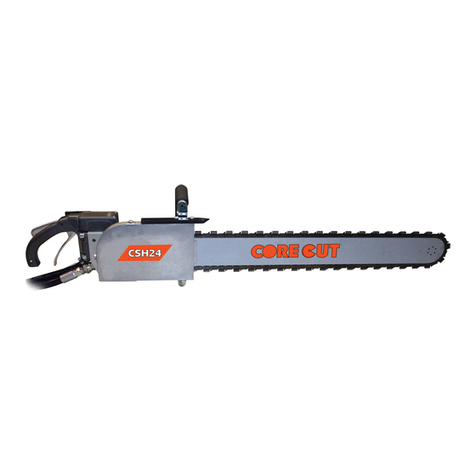Feider Machines FTRTPRO55 User manual

ORIGINAL INSTRUCTIONS
1
INSTRUCTION MANUAL
PETROL CHAIN SAW
FTRTPRO55
BUILDER SAS
32, rue Aristide Bergès -ZI 31270 Cugnaux –France
Warning: read the following instructions before using the machine
Made in China - 2020

ORIGINAL INSTRUCTIONS
2
CONTENTS
1. SECURITY INSTRUCTIONS 3
2. YOUR PRODUCT 7
3. ASSEMBLY 9
4. FILLING THE FUEL TANK 11
5. OPERATION 12
6. MAINTENANCE AND STORAGE 17
7. DECLARATION OF CONFORMITY 20

ORIGINAL INSTRUCTIONS
3
1. SAFETY WARNINGS
WARNING! When using this type of garden tool, basic precautions should always be followed to reduce the risk of
fire, electric shock and injury.
Read all instructions carefully before attempting to use this product and retain these instructions. Be familiar with
all the operations described in these operating instructions. This product must be operated by experienced users.
Inexperienced users shall first be trained in all operations by a professional.
If you are giving this machine to others, please also provide them with this instructions manual.
Take into account all the markings affixed to the product (symbols, labels, technical information, etc.). The
symbols are explained in this manual.
Use this machine as described in this instruction manual. It is strictly forbidden to use this tool for applications
other than those described in this manual.
Failure to follow these instructions can result in serious injuries and, in some cases, death.
This product is intended for private domestic use only. Do not use it for commercial purposes.
Never let people unfamiliar with these instructions or children use this product.
National regulations may limit the use of the machine.
People under the age of 18 must not use this product
Keep in mind that the operator or user is responsible for accidents or risks to other persons or their property.
Do not use the tool if you are drunk, tired, under the influence of drugs or ill. Do not use the tool if you are not in
an adequate physical condition.
This tool is intended for outdoor use. Never use it indoors.
When transporting the machine:
oSecure the machine during transport to prevent loss of fuel, damage or injury.
oUse a carrying case to protect the cutter during transport.
Keep people and animals away from the work area. Children and people who do not know how to use this tool
should not touch it and handle it.
Keep them at least 15 m from the machine during operation,
Use the product only under daylight or under good artificial light.
When using the machine, always wear full protective equipment including a helmet, protective mask, ear
protection, gloves, non-slip footwear and protective clothing.
Wear appropriate clothing. Do not wear loose or unbuttoned shirts. Do not wear jewellery that may come in
contact with moving parts. If you have long hair, tie it down and wear an appropriate safety helmet.
Do not operate the product with damaged guards or shields in place.
Keep hands and feet of the appliance at all times and especially when turning the appliance off and on.
Do not use the tool in an area where ventilation is poor. Gas emissions can cause injury.
Do not use the tool in the presence of flammable liquids or gases.
Caution: The machine releases gases when it is used. Avoid coming into contact with these gases.
Keep the work area clear. Before working, inspect the work area and remove any materials or objects that could
cause accidents.
Do not force the tool.
Use only accessories supplied or recommended by the manufacturer (such as saw chain and guide bar
combinations). Using other accessories may cause an accident. Refer to the “Technical Information” section of
this manual or ask your dealer for advice.
The risks of slipping and skidding must be foreseen as there is a high risk of kickback. Do not lean. Keep a good
balance at all times. Do not lose your balance at the end of a cut.
Always inspect the machine before and after operation. If the tool is damaged or faulty, stop using the tool and
bring it to an authorized service for inspection and repair.
Turn off the tool after use, when you leave it unattended, when changing these accessories and before servicing.
Be concentrated when using the tool. Look at what you do, use good sense and do not use the tool when you are
tired.
Remove the blade guard before using the tool.
A damaged guard or other part must be properly repaired or replaced by an authorized service center, unless
otherwise specified in this instruction manual.
Do not use the tool if the starter is not working (if it cannot be turned ON and OFF).
Immediately stop the tool in the event of a malfunction of the motor or in case of unusual noise.
Do not use the tool if the starter is damaged.
Do not move the chain with your hand with the wheel moving.
Do not stop the chain with your hands or other objects.
Treat the chain teeth with caution during operation; they can cause severe cuts.
When not in use, the machine must be stored in a dry, locked place out of the reach of children.

ORIGINAL INSTRUCTIONS
4
Before using the product and after any shock, please check it for signs of wear or damage. Please carry out
repairs if necessary.
Always switch off the machine:
oEvery time you leave the device unattended;
oBefore releasing an obstruction;
oBefore checking, cleaning or working on the product;
oAfter hitting a foreign object;
oEvery time the product starts to vibrate abnormally.
Pay attention to foot and cutting injuries.
Inspect and regularly service the product. Repairs should be carried out only by an authorized service center or a
similar qualified specialist.
When not in use, the machine must be stored in a locked dry place, out of the reach of children.
When transporting the tool, always add the blade guard to the blade. Always carry the tool by holding the handle,
never the blade.
Do not use the product on a slippery surface.
Do not use the product on steep, slippery slopes.
When planning your work schedule, allow enough time for rest. Limit continuous use of the device, eg use 30 ~ 40
minutes per session, and take 10 ~ 20 minutes of rest between work sessions. Work a maximum of two hours per
day
If the machine has struck foreign objects, check if the tool is damaged and bring it to repair if necessary.
Do not place any part of the body on the chain when the chainsaw is operating. Before starting the chain saw,
make sure that the chain is not in contact with anything. A moment of inattention during use may cause your
clothing or body part to stick to the chain.
Always hold the chainsaw back handle with your right hand and the front handle with your left hand. Hold the
chainsaw by inverting your hands increases the risk of personal injury and should never be used.
For the chainsaw designed with the chain guide on the left side, the reference to the "right hand" and "left hand"
positions is reversed.
When cutting a branch that is under stress, pay attention to the risk of elastic return. When the tension of the wood
fibres is released, the spring-loaded limb may strike the operator and / or project the chain saw out of control.
Exercise extreme caution when cutting brush and young shrubs. Fine materials can grip the cutting chain and be
thrown as a whip in your direction, or you lose balance under the effect of traction.
Follow the instructions for lubrication, tension and chain change accessories. A chain whose tension and
lubrication are incorrect can either break or increase the risk of rebound.
Keep handles dry, clean and free of oil and grease. Oily, greasy grips are slippery and cause loss of control.
Be careful when using the machine during stormy weather. Do not use the machine during lightning,
thunderstorms or in bad weather. Do not expose the tool to rain.
Do not use the tool in damp environment
It is recommended to use the spiked bumper provided for cutting trees and thick branches.
Perform regular functional check of the clutch. It should be no have chain movement at idling speed.
When operating the tool, be careful of the emission of exhaust gases, lubrication oil mist and saw dust; avoid to be
exposed to these and wear protective equipment.
Wear protective gloves when assembly, disassembly, sharpening chain tensioning and when handling the guide
bar.
Guide-bar and chain adjustments should be performed with the engine stopped (machine switched off).
Regularly check and test the chain brake.
Hazards may be encountered while using the saw, such as blockage of the saw chain, in order to reduce hazards,
follow the instruction for cutting operation; always check the condition of the tool, do not start the chainsaw directly
in the tree.
Fuel Handling
Be very careful when handling fuels. They are flammable and the vapors are explosive.
Use only an approved container.
Never remove the fuel cap or add fuel while the machine is on. Turn off the unit and allow the engine and exhaust
components to cool before refuelling.
Do not smoke.
Never refuel inside a room.
Never store the tool and the fuel tray indoors where there is a naked flame, such as near a water heater.
If fuel has spilled, do not attempt to start the machine, but rather move it away from the spill before starting to use
it. Clean any spills.
Replace and tighten the fuel tank cap after refuelling.
Follow the instructions in this manual for filling the tool with fuel.

ORIGINAL INSTRUCTIONS
5
During maintenance and storage
Stop the tool and wait until it stops. Make sure all moving parts have come to a standstill.
Allow the machine to cool before performing inspection, adjustments, maintenance, servicing and storage.
Store the tool where fuel vapor will not reach a flame or spark.
When transporting and storing, always place the tool in its transport guard and protective device on it.
Causes of rebounds and prevention by the operator
Bounce may occur when the spout or end of the chain guide touches an object, or when the wood tightens and
pinches the cutting chain in the cutting section.
The contact of the tip may in some cases cause a sudden reverse reaction by bouncing the chain guide up and
back towards the operator.
Pinching of the cutting chain on the upper part of the chain guide can force the chain guide to the operator
abruptly.
Either of these reactions can result in loss of control of the saw likely to result in a serious personal injury. Do not
rely exclusively on safety devices built into your saw. As a chain saw user, all measures should be taken to
eliminate the risk of accident or injury during cutting.
Bounce results from improper use of the tool and / or incorrect operating procedures or conditions and can be
avoided by taking the appropriate precautions specified below:
- Hold the saw with both hands firmly with the thumbs and fingers encircling the handles of the saw and place
your body and arms to allow you to withstand the rebound forces. The rebound forces can be controlled by
the operator, if appropriate precautions are taken. Do not allow the chain saw to start.
- Do not stretch the arm too far and do not cut above the shoulder height. This helps prevent unintentional end
contacts and allows better control of the chain saw in unforeseen situations.
- Use only the manufacturers specified replacement guides and chains. Incorrect replacement guides and
chains may cause chain breakage and / or rebound.
- Follow manufacturer's instructions for sharpening and servicing the chain saw. A decrease in the depth gauge
level can lead to an increase in rebounds.
Residual risks
Even if you use this product in accordance with all safety requirements, the potential risks of injury and damage
remain. The following dangers can occur:
- There are adverse health consequences resulting from the emission of vibrations if the tool is used for long
periods of time or is not properly managed and properly maintained.
- The vibrations can produce the so-called “white finger” disease. If any of the symptoms of "white finger" syndrome
appear, seek medical attention immediately. Symptoms of “white finger” include: numbness, loss of sensitivity,
tickling, tingling, pain, loss of strength, changes in color or skin condition. These symptoms usually appear on the
fingers, hands, or wrists. The risk increases at low temperatures. In order to reduce this risk, please wear gloves
and keep your hands warm. Limit the operating time.
- There is a risk of hearing loss with prolonged use, especially if hearing protection is not worn. Always wear
hearing protection and limit the operating time.
Symbols
Symbol warning of a warning
Read and refer to these operating instructions
Wear safety equipment that includes a helmet, protective helmet and protective goggles
Guarantee sound power level
The contact of the end of the bar with any object must be avoided.

ORIGINAL INSTRUCTIONS
6
Do not operate the tool with one hand. Always hold it with both hands.
Wear protective gloves
Wear protective foot wear.
Do not use the tool under and in moist environment
Intended use
This chainsaw is intended for use in cutting wood and trees. Do not cut metal objects, sheet metal, plastic and any
object and material that is not wood.
This chainsaw is intended for private household use only. Do not use it for commercial purposes.

ORIGINAL INSTRUCTIONS
7
2. YOUR PRODUCT
a. Description

ORIGINAL INSTRUCTIONS
8
1- Chain
2- Chain Guide
3- Handle protection
4- Main handle
5- Safety trigger
6- Accelerator throttle
7- Rear handle
8- Fuel tank
9- Starter rope
10- Oil tank
11- Guide chain protection
12- bracket
13- screws
14- Bottle for fuel mixture
15- Tool kit
16- Air filter
17- Fastening nut
18- Screws of fixation
19- ON/OFF switch
20- Choke lever
-The front hand guard is a device intended to protect the operator's hand against injuries
caused by contact with the chain.
-The chain brake is a device that automatically stops the chain in case of backward
movement, causing the saw to jump.
-The chain is the cutting device, installed on the chain guide.
Technical data
Model
FTRTPRO55
Type of engine
RY1E45F (air cooled 2-stroke petrol
engine)
Fuel Tank Volume
550cm³
Oil tank volume
260cm³
Idle speed of the engine
3100±300/min
Engine speed with clutch
engage
4300/min
Maximum power
2.0 kW
Displacement
53cm³
Maximum engine speed
11000/min
Maximum chain speed
21.2m/s
Weight (empty tank, without
accessories)
5.1 kg
Cutting length
470mm (20’’)
Chain pitch
8,255 (0,325’’)
Gauge of chain
1,47 (0,058’’)
Type of chain
21BPX078X/OREGON
Type of guide bar
208PXBK095(546874)/OREGON
Sprocket (number of teeth x
pitch)
7 Teethx8, 255
Carburettor
WT972A/Walbro, WT664A/Walbro
WT978/Walbro, 1E44F/Jingke
MC16A10/Hlic, MC16A7/HLIC,
MC16A7-1/HLIC, MC16A10P/HLIC,
MC1613B/HUAYI,MC1613/HUAYI,
MC1600/HUAYI,WT966/Walbro,
WT974/Walbro
Spark plug
L8RTF/LD NHSP,L8RTF/BOSCH
Sound Pressure
Uncertain K
LpA,eq: 93dB(A)
Uncertain KpA=3,0dB(A)
Sound power
LWA,eq: 108,7 dB(A) KwA=3,0dB(A)
Guaranteed power level
LwA : 114dB(A) (2000/14/EC)
Value of vibration
Front handle 10,0 m/s²K=1.5 m/s²
Rear handle: 9,0 m/s²K=1,5 m/s²

ORIGINAL INSTRUCTIONS
9
3. ASSEMBLY
a. Assembly of the chain guide
IMPORTANT: The machine must not be started during assembly. Wear protective
gloves when handling the blade.
1) Pull the guard toward the front handle to check that the chain brake is not engaged.
2) Loosen the nuts and remove the chain cover.
3) Attach the bracket to the rear of the engine assembly with a screw.
4) Install the guide and mount the chain on the pinion and guide in the direction shown
in the diagram.
5) Reinstall the cover and screw it with the two screws.
6) Adjust the chain tension by turning the tension screw until the straps touch just the
bottom side of the bar. Check if the chain is rotated correctly and tight.

ORIGINAL INSTRUCTIONS
10
While lifting the chain guide, turn the content screw to apply correct tension to the
chain.
Then lock the crankcase nuts.
Rotate the chain with your hand to check that it is turning without excessive
resistance and that it is properly tightened.
Repeat the installation if the chain is not tight.
b. Adjusting the chain tension
The tool motor must be switched off before adjusting the chain tension.
Make sure that the chain is inside the groove of the guide. Hold the guide by its tip. Adjust
the tension of the chain with the tension adjustment screw until the chain teeth touch the
bottom of the guide.
Turn the chain tension adjustment screw clockwise until the chain is tight. Do not stretch
the chain too much. Check the tension of the chain and check if the casing is properly
tightened. If this is not the case, please repeat the procedure.

ORIGINAL INSTRUCTIONS
11
4. REFUELLING
1) Fuel tank
WARNING: When filling the tank:
The chainsaw must always be stopped and cooled.
Never smoke during refueling. It must not have flames or sparks near the fuel.
Before refueling, allow the chainsaw to cool completely. Do not attempt to refuel when
the engine is hot.
If fuel has been spilled, immediately stop refueling and do not start the engine. Clean
up the spill and fill the machine in another location
Never fill the fuel tank to the flange; there is a risk of overflow.
Do not refuel in a closed and unventilated area.
The fuel used for this tool is a mixture of unleaded gasoline and registered engine lubricant.
When mixing gasoline with oil, use only gasoline that does not contain ethanol or methanol.
Unleaded gasoline is a quality gasoline type. This will help to avoid damaging the fuel lines of
the engine and other engine parts.
The recommended mixing ratio is 40:1 (make sure the mixing ratio is correct before filling the
product.
a. Mixing
Mix in a clean, empty container (supplied).
Pour the oil into the container.
Pour the fuel into the tank. Mix the mixture long enough (more than one
minute) to get a good combination.
b. Filling the fuel tank
Unscrew the fuel tank cap and remove it.
Fill the tank slowly with the mixture. Do not exceed the maximum capacity (fill to 80%
of its capacity preferably).
Replace the cap on the fuel tank and tighten it
Wipe any spillage around the unit if necessary
Note: To avoid damage and accidents, DO NOT USE OTHER MIXTURES AND OTHER
TYPES OF OIL / PETROL
c. Storage of fuel
The fuel must be kept in a clean and safe container and always closed.
If you are not using the product for a long time, remove the fuel mixture and add it to a
container.
Do not leave the fuel for a long time in the product. The fuel may clog the carburetor and
the engine will not operate properly.
d. Disposal of fuel
When the fuel is no longer used or worn, please dispose of it in an authorized location.
Check local laws regarding disposal of fuels
2) Oil tank
-Unscrew the oil tank
-Fill the tank with quality chain oil. Do not overfill.
-Replace the cap on the tank. Wipe any spillage if necessary.

ORIGINAL INSTRUCTIONS
12
5. OPERATION
IMPORTANT: Starting shall always be done with the chain brake activated. See on
pages 15-16 how to achieve this.
Before using the chainsaw, inspect the work area. This must be cleared. Remove any
branches, obstacles and other items that may cause damage during cutting.
The unit should always be filled with fuel
Check the level of filling and refill when necessary.
1. Starting the engine
a. Activate the chain brake by pushing it forward.
b. Set the switch to position I.
c. Pull the choke lever. It will close and the throttle will be moved to the starting position
Hold the chainsaw firmly against the ground. Put the chainsaw:
Either on the left side of your body holding the handle firmly with your left
hand. Use your right hand to pull the starter rope

ORIGINAL INSTRUCTIONS
13
Either on the right side of your body holding the handle firmly with your right
hand.
Use your left hand to pull on the starter rope.
In both cases, the saw must remain away from the operator's body.
-Push lightly the lock throttle and then the accelerator throttle to start working.
2. Stopping the engine
Allow the chainsaw to run for a few minutes. Then turn the switch to the OFF position.

ORIGINAL INSTRUCTIONS
14
3. Main settings
a. Adjusting the carburetor
The carburetor is preset at the factory. To avoid malfunction, it is recommended not
to adjust the adjustment screws. If these screws require readjustment, have the
machine serviced by your service center.
Stop the tool and tighten the needle L until it stops. Do not force it. Then set it to its
initial number of turns as shown below. The number of turns for the needle is also
shown below:
b. Chain brake
The chain brake is a device that automatically stops the chain in case a backward
movement occurs, causing the saw to jump. Normally, the brake is automatically
activated by the inertia force.
It is also manually tightened by pushing the brake lever down and forward.
When the brake is running, a yellow sign comes out from the base of the brake lever.
To release the brake, pull the brake lever up until it clicks into place.
When the brake is working, release the throttle lever to slow down the engine speed.
Continuous use when the brake is running causes the clutch to heat up and can
cause problems.
When checking the machine before using it, check the operating condition of the
brake by performing the following operations:
Start the engine and grasp the handle firmly with both hands.
While pulling the throttle control lever to keep the chain in operation, push
the brake lever down with the back of the left hand.
When the brake is running and the chain is stopped, remove the hand from
the throttle.
Loosen the brake.

ORIGINAL INSTRUCTIONS
15
c. Release of the chain brake
To use the chain saw again, the chain brake must be released. This must be done
machine off and cooled. Pull the shield until it returns to its original position.
d. Sharpening of the chain
For best performance, we strongly recommend that you periodically sharpen the
chain. The chain can either be sharpened by a professional or by yourself by
providing you with a sharpening guide (make sure you know how to use it).
The chain must be sharpened when:
- Wood chips have become powder
- To make a normal cut, force on the tool
- The cut is not straight
- Vibration increases
- Fuel consumption has increased
e. Checking the lubrication of the chain
- Before checking the oil, make sure that the bar and the chain are in place.
- Once the engine is started, turns it at medium speed and checks that the chain
oil is sprayed and traces off the ground.
- The oil flow of the chain is adjustable to obtain the proper flow. Insert a
screwdriver on the clutch side.
- Turn the adjuster to obtain the correct flow rate for the job.
- The chainsaw must essentially consume the contents of the oil tank between
each full of fuel. Do not forget to fill the oil tank when filling the machine with fuel.
4. Cutting work
The tool should only be used to cut trees. Do not use it for other applications.
Do not attempt to remove the chainsaw when it is stuck during operation. Stop the
machine and remove the wedge blade with a wedge.
Stick your feet well, keep a good balance and do not climb on the tree trunk.
Try not to work on a slope. However, if you have to work on a slope, always stand higher
than the tree trunk.
Before bending a branch or trunk in bending, observe the direction of bending and finish
the cut opposite the bending side to prevent the chain guide from getting stuck in the cut.

ORIGINAL INSTRUCTIONS
16
a. Felling of trees
Examine the work area and estimate where the tree will fall. Start the machine as
described above. Start by making a notch in the direction of fall chosen.
When the tree falls, shout or make a beep to alert people in the vicinity. When the shaft
falls, you must move away from the cutting area.
b. Trunk on the ground
Cut half of the trunk, turn it over and finish the cut on the other side.
c. Trunk in elevation
Begin by cutting a first part from below and then from above. Then, on the second part,
repeat this operation.
b. Pruning of a felled tree
Observe first the direction of flexion of the branch. Make a first notch on the side in
flexion and finish the cut on the opposite side.
c. Pruning a tree
Begin pruning by nicking the tree from below and then finish at the top.

ORIGINAL INSTRUCTIONS
17
6. MAINTENANCE AND STORAGE
1. Maintenance
Before any maintenance work, the machine must be switched off and completely
cooled.
Perform the maintenance work according to the instructions below and perform
them regularly. A clean, well-maintained machine increases its standard of living
and efficiency. On the contrary, a machine maintained can cause damage,
accidents and render the tool inoperable in the short term.
Any other maintenance, modification or repair work must be carried out by a
qualified professional.
Do not immerse the tool in water or any other liquid.
a. After each use
-Clean the engine block louvers with a blower.
-Check the chain brake if it is working properly.
-Clean the plastic parts before wiping with a damp cloth.
-Check the use of the chain guide
-Check the auto lubrication circuit if it is obstructed or not.
-Check sprocket condition
-Clean the cylinder fins with a compressor
b. Cleaning the air filter
Use a compressor to blow dust and chips.
To clean the filter foam: open the air filter, remove the foam. Clean this foam with
gasoline, wring out and dry. Replace the foam in the air filter and reassemble as
described in the diagram.
After 10 uses, replace the foam with a new one.
c. Cleaning the oil filter and fuel filter
Clean these items regularly. Remove them from the tanks using clamps. Clean them
with gasoline and then put them back in place afterwards
d. Guide bar
Cleaning: Remove bar guide to remove dirt from grooves and oil inlet.
Regularly grease the pinion.

ORIGINAL INSTRUCTIONS
18
Check: Reverse the bar from time to time to avoid the effects of wear. The bar rail
should always be in place. Use a ruler to observe it. If a gap is observed between
them, then the rail is normal. Otherwise, the rail is worn out. A bar must be corrected
or replaced.
e. Sprocket
Check the sprocket on signs of wear. If wearing is important, replace it with a new
one. Do not install a chain on a worn or damaged sprocket. Do not install a worn
chain on a pinion.
f. Spark plug
Clean the electrodes with a wire brush and set the gap to 0.6mm if necessary.

ORIGINAL INSTRUCTIONS
19
g. chain saw
Check each time the cutter and cutting angles are as shown below.
h. Sharpening of the chain
For best performance, we strongly recommend that you periodically sharpen the
chain. The chain can either be sharpened by a professional or by yourself by
providing you with a sharpening guide (make sure you know how to use it).
The chain must be sharpened when:
-Wood chips have become powder
-To perform a normal cut, force on the tool#
-The cut is not straight
-Vibration increase
-Fuel consumption has increased
-Sharpening method:
The chain saw must be switched off and locked before sharpening. Use a round file
or sharpening device (see in store).
Place the file on the tooth and push straight. Shift with the same movement.
After sharpening all teeth, check if the teeth are sharp.

ORIGINAL INSTRUCTIONS
20
2. STORAGE
When storing, the tool must be turned off, cooled, emptied of fuel and thoroughly cleaned.
Store the tool in a dry, clean place, preferably in its packaging, and out of the reach of
children. Store all accessories and other items with the tool.
7. DECLARATION OF CONFORMITY
Declaration of conformity
BUILDER
ZI, 32 rue Aristide Bergès –31270 Cugnaux - France
Declares that the machinery designated below:
Petrol chainsaw
FTRTPRO55
Serial number: 20200727000-20200727149
Complies with the provisions of the Directive "Machine" 2006/42/EC and regulations
National transposing it;
Also complies with the following European directives:
EMC Directive 2014/30/UE
Noise emission Directive 2000/14/EC Annex V and Directive 2005/88/EC
Emission directive: (EU) 2016/1628 & 2018/989/EU
Guarantee sound power level: 114 dB(A)
Measured sound power level: 108.7 dB(A) KwA=3,0dB(A)
Also complies with European standards, national standards and provisions following
techniques:
EN ISO 11681-1: 2011
EN ISO 14982: 2009
EC-type certificate number:
17SHW1919-04
Notified body EU 0905
Responsible of the Technical file: Mr Patriarca
Cugnaux, le 01/08/2020
Table of contents
Other Feider Machines Chainsaw manuals
